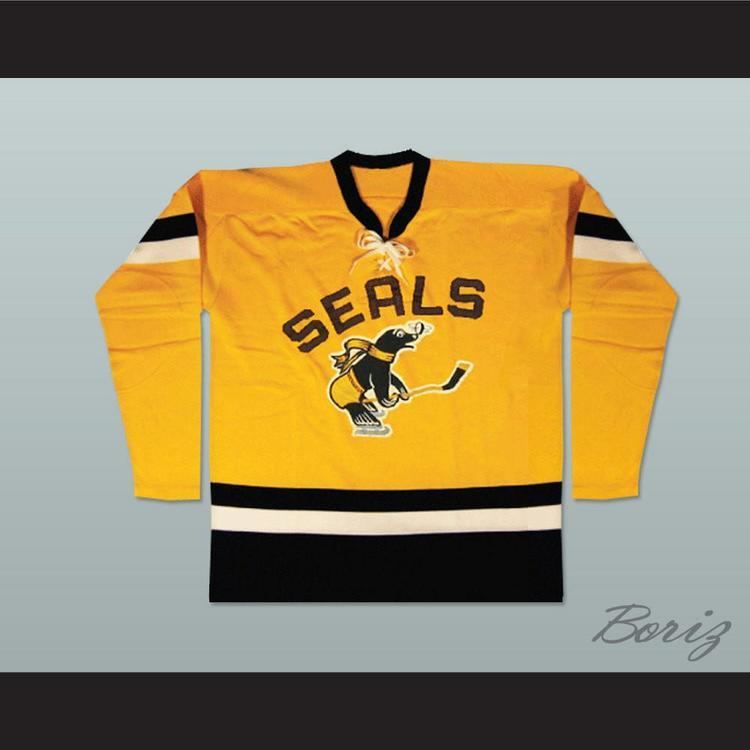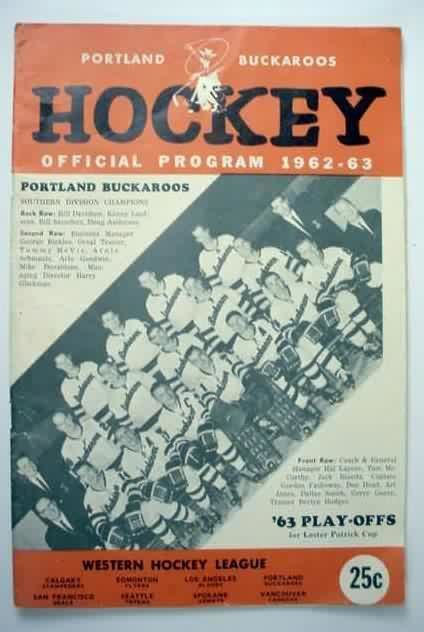League Western Hockey League Date founded 1961 | Color Green, yellow and white. | |
 | ||
Colours Green, yellow and white. Location San Francisco, California, United States | ||
The San Francisco Seals were a minor league hockey team which played in the Western Hockey League from 1961 to 1967.
Contents
- Pro hockey returns to California
- Championship years 1962 63 and 1963 64
- Move to Oakland and transition to the NHL
- After the WHL
- Season by season record
- References

Pro hockey returns to California
After his Spokane Comets were eliminated from the 1960-61 WHL playoffs, owner Mel Smith announced that he was considering moving the Comets to either San Francisco or Los Angeles. Los Angeles Sports Arena general manager Bill Nicholas had already told the National Hockey League that he would affiliate with the WHL if he were not awarded an NHL expansion franchise by the summer of 1961. As a result, WHL president Al Leader visited both the Cow Palace in Daly City and the Sports Arena to evaluate their availability for WHL play.

On April 23, 1961, the WHL granted an expansion franchise for San Francisco to former Vancouver Canucks owner Coleman (Coley) Hall, on the condition that an ice surface be installed in the Cow Palace. At the same time, the WHL approved the relocation of the Victoria Cougars to Los Angeles, where they were renamed the Los Angeles Blades. The San Francisco franchise, named the "Seals" in honor of the city's former minor league baseball team, and Blades were California's first pro hockey teams since the San Francisco Shamrocks and Los Angeles Monarchs left the Pacific Coast Hockey League, as the WHL was then known, in 1950.

Under coach Max McNab, the Seals debuted on Oct. 13, 1961 with an 8-3 road loss to the Seattle Totems at Civic Arena. Their first home game at the Cow Palace took place a month later, with the Seals losing 5-3 to Edmonton on Nov. 17. The Seals would finish 29-39-2 in their first season and were eliminated by Spokane 2 games to none in their first-round playoff series.
Championship years (1962-63 and 1963-64)

Following McNab's departure to take over the Vancouver Canucks, the Seals lured coach and general manager Norman "Bud" Poile south from the defending champion Flyers. Poile had won three championships in eight seasons at Edmonton; with the Seals, he would add two more.
Poile's teams generally led the league in penalty minutes, and his 1962–63 Seals fit the mold. Led by hard-nosed players such as Orland Kurtenbach, Larry McNabb, Nick Mickoski and Charlie Burns, the Seals developed a fierce rivalry with the Portland Buckaroos, perennial WHL front-runners. For the next two seasons, Portland-San Francisco games had the atmosphere of a heavyweight title fight, and games between the two routinely attracted crowds of 8,000 or more. The Blades were another rival; Cow Palace crowds loved to hate defenseman "Big Burly Bill Burega."
After finishing 44-25-1 in the 1962–63 regular season, the Seals eliminated Los Angeles in three games in the first round of the playoffs, then outlasted the Buckaroos in seven rugged semifinal contests, taking the seventh and final game 3-1 at Portland.
In the 1963 Lester Patrick Cup finals, the Seals faced the Totems, with all seven games played at the Cow Palace due to scheduling conflicts in Seattle. Trailing 3 games to 1, the Seals came back to win the last three games – the last two in overtime – and captured San Francisco's first pro hockey championship. Kurtenbach scored the Cup-winning goal 4 minutes into overtime of the Seals' 4-3 Game 7 victory.
Even though the WHL contracted in 1963–64 – Edmonton and Calgary both requested a leave of absence following the playoffs – the Seals finished a distant fourth during the regular season behind the Denver Invaders, who had relocated from Spokane. But superb play from forward Al Nicholson and goalie Bob Perreault helped the Seals win the final three games of their first-round playoff series against Portland. The Seals would go on to become the first team to win back-to-back Patrick Cup titles, defeating the Blades in six games in the only all-California final.
Move to Oakland and transition to the NHL
In 1965, while the Seals were en route to missing the playoffs for the only time in their existence, the NHL announced that it planned to expand through the creation of a second six-team division – a move prompted by the desire for a new U.S. television contract, as well as rumors that the WHL and American Hockey League were considering merging to form a rival major league. The WHL and AHL played an interlocking schedule in 1965-66, but by then the NHL had made up its mind.
In February 1966, the NHL selected San Francisco-Oakland as one of the six expansion markets, along with Los Angeles, Pittsburgh, Philadelphia, Minneapolis–St. Paul and St. Louis. Rather than build a brand new expansion club, Barend (Barry) van Gerbig purchased the team from Mel Swig, with intent of bringing the club into the NHL as the expansion team. In the process he became the Seals' new owner and prospective governor for the team's entry into the NHL. By then, Poile had turned over the coaching reins to player-coach Charlie Burns; the Seals reached the 1966 WHL playoffs and were one game away from their third finals appearance, but lost the last two games of their first-round playoff series against the eventual WHL champion Victoria Maple Leafs, which prevailed 4 games to 3.
Following the playoff defeat, van Gerbig began preparing the Seals for their move to the NHL. He relocated the club from the Cow Palace to the brand-new Oakland–Alameda County Coliseum across the bay in Oakland for what was their final WHL season in 1966-67, changing their name to the California Seals. Former Chicago Black Hawks coach Rudy Pilous took over as coach, alternating duties with Burns, as the Seals recorded only their second winning record (32-30-10). The Seals' six-year run in the WHL ended when they were eliminated in the first round of the playoffs by Seattle; California's final WHL game was a 4-1 loss to the Totems on April 15, 1967, at the Seattle Center Coliseum.
Tom Thurlby, one of the first five players signed by the Seals on September 7, 1961, was the only Seal to remain with the team for all six of its seasons in the WHL. He would also play 20 games for the NHL Seals in 1967-68.
When the club joined the NHL, Gerbig retained a portion of the club's WHL roster -- Charlie Burns, George Swarbrick, Gerry Odrowski, Tom Thurlby and Ron Harris. The rest of the club was built through an expansion draft.
After the WHL
When the franchise joined the NHL in 1967, it retained the name "California Seals" in an effort to appeal to fans in both San Francisco and Oakland. However, after only a few months, the team had failed to attract many fans from San Francisco, and the name was changed to Oakland Seals. The name was later changed again to California Golden Seals in 1970; the franchise eventually moved to Cleveland in 1976 before it folded in 1978 through a merger with the Minnesota North Stars.
The NHL would return to the San Francisco Bay Area with the foundation of the San Jose Sharks, who were spun off from the North Stars in 1991 and were operated under ownership that had held a stake in the Seals.
Season-by-season record
Note: GP = Games played, W = Wins, L = Losses, T = Ties, Pts = Points, GF = Goals for, GA = Goals against, PIM = Penalties in minutes
